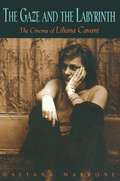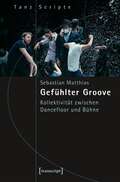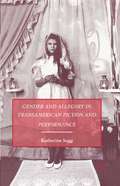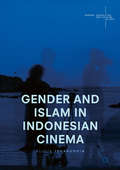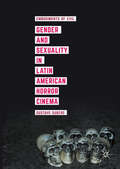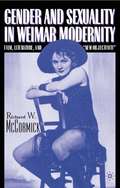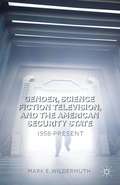- Table View
- List View
The Gaze and the Labyrinth: The Cinema of Liliana Cavani
by Gaetana MarroneIn this, the first comprehensive book on Liliana Cavani, Gaetana Marrone redraws the map of postwar Italian cinema to make room for this extraordinary filmmaker, whose representations of transgressive eroticism, spiritual questing, and psychological extremes test the limits of the medium, pushing it into uncharted areas of discovery. Cavani's film The Night Porter (1974) created a sensation in the United States and Europe. But in many ways her critically renowned endeavors--which also include Francesco di Assisi, Galileo, I cannibali, Beyond Good and Evil, The Berlin Affair, and several operas and documentaries--remain enigmatic to audiences. Here Marrone presents Cavani's work as a cinema of ideas, showing how it takes pleasure in the telling of a story and ultimately revolts against all binding ideological and commercial codes. The author explores the rich visual language in which Cavani expresses thought, and the cultural icons that constitute her style and images. This approach affords powerful insights into the intricate interlacing of narrated events. We also come to understand the importance assigned to the gaze in the genesis of desire and the acquisition of knowledge. The films come to life in this book as the classical tragedies Cavani intended, where rebels and madmen experience conflict between historical and spiritual reality, the present and the past. Offering intertextual analyses within such fields as psychology, history, and cultural studies, along with production information gleaned from Cavani's personal archives, Marrone boldly advances our understanding of an intriguing, important body of cinematic work.
The GC: How to Be a Diva
by Gemma CollinsFor fans of TOWIE, Celebrity Big Brother and Celebs Go Dating, learn how you too can become a diva by the one and only Gemma Collins - one of the greatest gifts reality TV has ever given us.So girls, you alright darlings?By buying this book you will have taken the first steps into a world where everything is fabulous. Men will fall at your feet, riches will be bestowed on you, you will have the biggest, bounciest hair ever and you will get what you want, whatever that is. I'm a diva and I've earned my divaship through many years of hard work, hairdryers and broken hearts. In my book, I'll explore the main themes of the diva lifestyle: attitude, appearance, men and social media. You'll learn what it means to be a diva, how to look like one, how to act like one and how to live like one. At the end of it all, you will be a fabulous diva like me. You'll also learn some very juicy goss about me, my life, the men in my life, shock-induced urinary incontinence and some of the things I've done (including how I sustained an unsightly boob injury in front of Tom Daley while he was wearing a revealing pair of Speedos) (which could probably make a book on its own). So hold on to your extensions, because things are about to get interesting.
The Geek's Guide to SF Cinema: 30 Key Films that Revolutionised the Genre
by Ryan Lambie'Awesome. Everything you've ever wanted to know about big-screen sci-fi' - James King, film critic'Don't leave Planet Earth without it' - Dan Jolin, film critic'A wonderfully accessible, fascinating, flat-out treasure chest of science fiction cinema, from an author whose love of the subject leaps off the page' - Simon Brew, Editor, Den of GeekWhy do SF movies matter? What do they tell us about the interests of storytellers and the changing tastes of cinema-goers? How have SF movies evolved with filmmaking technology over the past 110 years?The Geek's Guide To SF Cinema provides an entertaining and in-depth history of the science fiction genre's pivotal and most influential movies. From the pioneering films of Georges Méliès to such blockbusters as Avatar and Inception in the 21st century, the book will explore how these key movies were made, how they reflected the mood of the time in which they were released and how they have influenced other filmmakers in the years since.Historians and experts contribute to answer questions such as: 'How important was Fritz Lang's contribution to cinema?' and 'What did Alien say about the cynical climate of the 1970s?'. Providing nostalgia for long-time SF addicts and context for those whose knowledge and love of the genre is still growing, this is a pop-culture book with depth.
Gefühlter Groove: Kollektivität zwischen Dancefloor und Bühne (TanzScripte #49)
by Sebastian MatthiasAllwöchentlich strömen Besucher in Clubs mit elektronischer Tanzmusik und suchen das intensive kollektive Rhythmuserlebnis: den gefühlten Groove. Doch wie leiten verknüpfte Synchronisierungsprozesse - nicht nur im Clubtanz, sondern auch in der zeitgenössischen Bühnentanzkunst - die Bewegungen der Tanzenden? Sebastian Matthias entwirft in seiner künstlerischen Forschung Kategorien zur Erfassung von Gruppendynamiken, die einerseits auf Choreographien für die Bühne und andererseits auf Bewegungsanalysen in Elektroclubs basieren. In der Vielzahl der Bewegungsmuster auf der Tanzfläche ist er dem pluralistisch organisierten, potentiell endlosen choreographischen Groove auf der Spur.
Gender and Allegory in Transamerican Fiction and Performance
by K. SuggBy rethinking contemporary debates regarding the politics of aesthetic forms, Gender and Allegory in Transamerican Fiction and Performance explores how allegory can be used to resolve the "problem" of identity in both political theory and literary studies. Examining fiction and performance from Zoé Valdés and Cherríe Moraga to Def Poetry Jam and Carmelita Tropicana, Sugg suggests that the representational oscillations of allegory can reflect and illuminate the fraught dynamics of identity discourses and categories in the Americas. Using a wide array of theoretical and aesthetic sources from the United States, Latin America, and the Caribbean, this book argues for the crucial and potentially transformative role of feminist cultural production in transamerican public cultures.
Gender and Dance in Modern Iran: Biopolitics on stage (Iranian Studies)
by Ida MeftahiGender and Dance in Modern Iran: Biopolitics on Stage investigates the ways dancing bodies have been providing evidence for competing representations of modernity, urbanism, and religiosity across the twentieth century. Focusing on the transformation of the staged dancing body, its space of performance, and spectatorial cultural ideology, this book traces the dancing body in multiple milieus of performance, including the Pahlavi era’s national artistic scene and the popular café and cabaret stages, as well as the commercial cinematic screen and the post-revolutionary Islamized theatrical stage. It links the socio-political discourses on performance with the staged public dancer, in order to interrogate the formation of dominant categories of "modern," "high," and "artistic," and the subsequent "othering" of cultural realms that were discursively peripheralized from the "national" stage. Through the study of archival and ethnographic research as well as a diverse literature pertaining to music, theater, cinema, and popular culture, it combines a close reading of primary sources such as official documents, press materials, and program notes with visual analysis of filmic materials and imageries, as well as interviews with practitioners. It offers an original and informed exploration into the ways performing bodies and their public have been associated with binary notions of vice and virtue, morality and immorality, commitment and degeneration, chastity and eroticism, and veiled-ness and nakedness. Engaging with a range of methodological and historiographical methods, including postcolonial, performance, and feminist studies, this book is a valuable resource for students and scholars of Middle East history and Iranian studies, as well as gender studies and dance and performance studies.
Gender and Dance in Modern Iran: Biopolitics on stage (Iranian Studies)
by Ida MeftahiGender and Dance in Modern Iran: Biopolitics on Stage investigates the ways dancing bodies have been providing evidence for competing representations of modernity, urbanism, and religiosity across the twentieth century. Focusing on the transformation of the staged dancing body, its space of performance, and spectatorial cultural ideology, this book traces the dancing body in multiple milieus of performance, including the Pahlavi era’s national artistic scene and the popular café and cabaret stages, as well as the commercial cinematic screen and the post-revolutionary Islamized theatrical stage. It links the socio-political discourses on performance with the staged public dancer, in order to interrogate the formation of dominant categories of "modern," "high," and "artistic," and the subsequent "othering" of cultural realms that were discursively peripheralized from the "national" stage. Through the study of archival and ethnographic research as well as a diverse literature pertaining to music, theater, cinema, and popular culture, it combines a close reading of primary sources such as official documents, press materials, and program notes with visual analysis of filmic materials and imageries, as well as interviews with practitioners. It offers an original and informed exploration into the ways performing bodies and their public have been associated with binary notions of vice and virtue, morality and immorality, commitment and degeneration, chastity and eroticism, and veiled-ness and nakedness. Engaging with a range of methodological and historiographical methods, including postcolonial, performance, and feminist studies, this book is a valuable resource for students and scholars of Middle East history and Iranian studies, as well as gender studies and dance and performance studies.
Gender and Islam in Indonesian Cinema
by Alicia IzharuddinThis book presents a historical overview of the Indonesian film industry, the relationship between censorship and representation, and the rise of Islamic popular culture. It considers scholarship on gender in Indonesian cinema through the lens of power relations. With key themes such as nationalism, women's rights, polygamy, and terrorism which have preoccupied local filmmakers for decades, Indonesia cinema resonates with the socio-political changes and upheavals in Indonesia’s modern history and projects images of the nation through the debates on gender and Islam. The text also sheds light on broader debates and questions about contemporary Islam and gender construction in contemporary Indonesia. Offering cutting edge accounts of the production of Islamic cinema, this new book considers gendered dimensions of Islamic media creation which further enrich the representations of the 'religious' and the 'Islamic' in the everyday lives of Muslims in South East Asia.
Gender and Islam in Indonesian Cinema
by Alicia IzharuddinThis book presents a historical overview of the Indonesian film industry, the relationship between censorship and representation, and the rise of Islamic popular culture. It considers scholarship on gender in Indonesian cinema through the lens of power relations. With key themes such as nationalism, women's rights, polygamy, and terrorism which have preoccupied local filmmakers for decades, Indonesia cinema resonates with the socio-political changes and upheavals in Indonesia’s modern history and projects images of the nation through the debates on gender and Islam. The text also sheds light on broader debates and questions about contemporary Islam and gender construction in contemporary Indonesia. Offering cutting edge accounts of the production of Islamic cinema, this new book considers gendered dimensions of Islamic media creation which further enrich the representations of the 'religious' and the 'Islamic' in the everyday lives of Muslims in South East Asia.
Gender and Media in the Broadcast Age: Women’s Radio Programming at the BBC, CBC, and ABC
by Justine LloydThe 20th century was a time of rapid expansion in media industries, as well as of accelerating demands for equality and recognition for women. While women's agency has typically been defined through the domestic sphere, the introduction of media into the home destabilised firm boundaries between public and private spheres.Gender and Media in the Broadcast Age demonstrates how women as media producers and audiences in three countries with public service broadcasters (UK, Canada and Australia) have contributed to changes in our understandings of public and private. Justine Lloyd offers a new way of understanding how tremendous changes in social definitions of gender roles played out in media forms worldwide during this period through the notion of 'intimate geographies'. Women's participation in media continues to be a key challenge to notions of the public sphere and the book concludes that profound changes initiated in the broadcast era are unfinished in the age of digital media. Lloyd therefore provides rich and valuable evidence of the dynamic relationship between media texts, producers and audiences that is relevant to contemporary debates about a growing gender 'apartheid' in a mediated culture.
Gender and Sexuality in Latin American Horror Cinema: Embodiments of Evil
by Gustavo SuberoGender and Sexuality in Latin American Horror Cinema explores the different mechanisms and strategies through which horror films attempt to reinforce or contest gender relations and issues of sexual identity in the continent. The book explores issues of machismo, marianismo, homosociality, bromance, among others through the lens of horror narratives and, especially, it offers an analysis of monstrosity and the figure of the monster as an outlet to play out socio-sexual anxieties in different societies or gender groups. The author looks at a wide rage of films from countries such as Cuba, Peru, Mexico and Argentina and draws points of commonality, as well as comparing essential differences, between the way that horror fictions – considered by many as low-brow cinema - can be effective to delve into the way that sexuality and gender operates and circulates in the popular imaginary in these regions.
Gender and Sexuality in Weimar Modernity: Film, Literature, and “New Objectivity”
by R. McCormickRichard McCormick takes a fresh look at the crisis of gender in Weimar Germany through the analysis of selected cultural texts, both literary and film, characterized under the label 'New Objectivity'. The 'New Objectivity' was characterized by a sober and unsentimental embrace of urban modernity, in contract to Expressionism's horror of technology and belief in 'auratic' art. This movement was profoundly gendered - the epitome of the 'New Objectivity' was the 'New Woman' - working, sexually emancipated, and unsentimental. The book traces the crisis of gender identities, both male and female, and reveals how a variety of narratives of the time displaced an assortment of social anxieties onto sexual relations.
Gender and the Nuclear Family in Twenty-First-Century Horror
by Kimberly JacksonGender and the Nuclear Family in Twenty-First-Century Horror is the first book-length project to focus specifically on the ways that patriarchal decline and post-feminist ideology are portrayed in popular American horror films of the twenty-first century. Through analyses of such films as Orphan, Insidious, and Carrie, Kimberly Jackson reveals how the destruction of male figures and depictions of female monstrosity in twenty-first-century horror cinema suggest that contemporary American culture finds itself at a cultural standstill between a post-patriarchal society and post-feminist ideology.
Gender-Based Violence and Digital Media in South Africa (Routledge Focus on Media and Cultural Studies)
by Millie Mayiziveyi PhiriThis book presents a new paradigm for attending to gender-based violence (GBV) social media discourse among marginalised Black women in South Africa. Focusing on the intersections of television and social media, the study charts the morphing and merging of the “inside” of the soap opera and the “outside” of the real world, amid a rise in feminist social media activism. The analysis begins with coverage of gender-based violence in a long-running South African soap opera and social media discussion of these issues, in parallel with real-world events and the collective social media response. The author offers pertinent insights into audiences in sub-Saharan Africa, presenting a new feminist trajectory for women and activism in the region. Offering new insights into an important issue, this book will be of interest to scholars and students of gender, cultural studies, film studies, television studies, sociology, development studies, feminism, media, and journalism.
Gender-Based Violence and Digital Media in South Africa (Routledge Focus on Media and Cultural Studies)
by Millie Mayiziveyi PhiriThis book presents a new paradigm for attending to gender-based violence (GBV) social media discourse among marginalised Black women in South Africa. Focusing on the intersections of television and social media, the study charts the morphing and merging of the “inside” of the soap opera and the “outside” of the real world, amid a rise in feminist social media activism. The analysis begins with coverage of gender-based violence in a long-running South African soap opera and social media discussion of these issues, in parallel with real-world events and the collective social media response. The author offers pertinent insights into audiences in sub-Saharan Africa, presenting a new feminist trajectory for women and activism in the region. Offering new insights into an important issue, this book will be of interest to scholars and students of gender, cultural studies, film studies, television studies, sociology, development studies, feminism, media, and journalism.
Gender, Cinema, Streaming Platforms: Shifting Frames in Neoliberal India
by Runa Chakraborty Paunksnis Šarūnas PaunksnisThis book offers interdisciplinary examination of gender representations in cinema and SVOD (Subscription Video on Demand) platforms in India. This book will identify how the so-called feminist enunciations in twenty-first century film and SVOD content in India are marked by an ambiguous entanglement of feminist and postfeminist rhetoric. Set against the backdrop of two significant contemporary phenomena, namely neoliberalism and the digital revolution, this book considers how neoliberalism, aided by technological advancement, re-configured the process of media consumption in contemporary India and how representation of gender is fraught with multiple contesting trajectories. The book looks at two types of media—cinema and SVOD platforms, and explores the reasons for this transformation that has been emerging in India over the past two decades. Keeping in mind the complex paradoxes that such concomitant process of the contraries can invoke, the book invites myriad responses from the authors who view the shifting gender representations in postmillennial Hindi cinema and SVOD platforms from their specific ideological standpoints. The book includes a wide array of genres, from commercial Hindi films to SVOD content and documentary films, and aims to record the transformation facilitated by economic as well as technological revolutions in contemporary India across various media formats.
Gender in Spanish Urban Spaces: Literary and Visual Narratives of the New Millennium
by Maria C. DiFrancesco Debra J. Ochoa Daphne SpainThis edited collection examines the synergistic relationship between gender and urban space in post-millennium Spain. Despite the social progress Spain has made extending equal rights to all citizens, particularly in the wake of the Franco regime and radically liberating Transición, the fact remains that not all subjects—particularly, women, immigrants, and queers—possess equal autonomy. The book exposes visible shifts in power dynamics within the nation’s largest urban capitals—Madrid and Barcelona—and takes a hard look at more peripheral bedroom communities as all of these spaces reflect the discontent of a post-nationalistic, economically unstable Spain. As the contributors problematize notions of public and private space and disrupt gender binaries related with these, they aspire to engender discussion around civic status, the administration of space and the place of all citizens in a global world.
Gender in Spanish Urban Spaces: Literary and Visual Narratives of the New Millennium
by Maria C. DiFrancesco Debra J. Ochoa Daphne SpainThis edited collection examines the synergistic relationship between gender and urban space in post-millennium Spain. Despite the social progress Spain has made extending equal rights to all citizens, particularly in the wake of the Franco regime and radically liberating Transición, the fact remains that not all subjects—particularly, women, immigrants, and queers—possess equal autonomy. The book exposes visible shifts in power dynamics within the nation’s largest urban capitals—Madrid and Barcelona—and takes a hard look at more peripheral bedroom communities as all of these spaces reflect the discontent of a post-nationalistic, economically unstable Spain. As the contributors problematize notions of public and private space and disrupt gender binaries related with these, they aspire to engender discussion around civic status, the administration of space and the place of all citizens in a global world.
Gender Inequality in Screenwriting Work
by Natalie WreyfordThis is the first book to critically examine the recruitment and working practices of screenwriters. Drawing on interviews with screenwriters and those that employ them, Natalie Wreyford provides a deep and detailed understanding of entrenched gender inequality in the UK film industry and answers the question: what is preventing women from working as screenwriters? She considers how socialised recruitment and gendered taste result in exclusion, and uncovers subtle forms of sexism that cause women’s stories and voices to be discounted. Gender Inequality in Screenwriting Work also reveals the hidden labour market of the UK film industry, built on personal connections, homophily and the myth of meritocracy. It is essential reading for students and scholars of gender, creative industries, film and cultural studies, as well as anyone who wants to understand why women remain excluded from many key roles in filmmaking.
Gender, Media and Voice: Communicative Injustice and Public Speech
by Jilly Boyce KayThis book explores the increasing imperatives to speak up, to speak out, and to ‘find one’s voice’ in contemporary media culture. It considers how, for women in particular, this seems to constitute a radical break with the historical idealization of silence and demureness. However, the author argues that there is a growing and pernicious gap between the seductive promise of voice, and voice as it actually exists. While brutal instruments such as the ducking stool and scold’s bridle are no longer in use to punish women’s speech, Kay proposes that communicative injustice now operates in much more insidious ways. The wide-ranging chapters explore the mediated ‘voices’ of women such as Monica Lewinsky, Hannah Gadsby, Diane Abbott, and Yassmin Abdel-Magied, as well as the problems and possibilities of gossip, nagging, and the ‘traumatised voice’ in television talk shows. It critiques the optimistic claims about the ‘unleashing’ of women’s voices post-#MeToo and examines the ways that women’s speech continues to be trivialized and devalued. Communicative justice, the author argues, is not about empowering individuals to ‘find their voice’, but about collectively transforming the whole communicative terrain.
Gender, Power, and Identity in The Films of Stanley Kubrick (Routledge Advances in Film Studies)
by Karen A. Ritzenhoff Dijana Metli 263 Jeremi SzaniawskiThis volume features a set of thought-provoking and long overdue approaches to situating Stanley Kubrick’s films in contemporary debates around gender, race, and age – with a focus on women’s representations. Offering new historical and critical perspectives on Kubrick’s cinema, the book asks how his work should be viewed bearing in mind issues of gender equality, sexual harassment, and abuse. The authors tackle issues such as Kubrick’s at times questionable relationships with his actresses and former wives, the dynamics of power, misogyny and miscegenation in his films, and auteur ‘apologism’, among others. The selection delineates these complex contours of Kubrick’s work by drawing on archival sources, engaging in close readings of specific films, and exploring Kubrick through unorthodox venture points. With an interdisciplinary scope and social justice-centered focus, this book offers new perspectives on a well-established area of study. It will appeal to scholars and upper-level students of film studies, media studies, gender studies, and visual culture, as well as to fans of the director interested in revisiting his work with a new perspective.
Gender, Power, and Identity in The Films of Stanley Kubrick (Routledge Advances in Film Studies)
by Karen A. Ritzenhoff Dijana Metlić Jeremi SzaniawskiThis volume features a set of thought-provoking and long overdue approaches to situating Stanley Kubrick’s films in contemporary debates around gender, race, and age – with a focus on women’s representations. Offering new historical and critical perspectives on Kubrick’s cinema, the book asks how his work should be viewed bearing in mind issues of gender equality, sexual harassment, and abuse. The authors tackle issues such as Kubrick’s at times questionable relationships with his actresses and former wives, the dynamics of power, misogyny and miscegenation in his films, and auteur ‘apologism’, among others. The selection delineates these complex contours of Kubrick’s work by drawing on archival sources, engaging in close readings of specific films, and exploring Kubrick through unorthodox venture points. With an interdisciplinary scope and social justice-centered focus, this book offers new perspectives on a well-established area of study. It will appeal to scholars and upper-level students of film studies, media studies, gender studies, and visual culture, as well as to fans of the director interested in revisiting his work with a new perspective.
Gender, Science Fiction Television, and the American Security State: 1958-Present
by M. WildermuthAs American security became increasingly dependent on technology to shape the consciousness of its populace and to defend them, science fiction shows like The Twilight Zone, Star Trek, and The X-Files both promoted the regime's gendered logic and raised significant questions about that logic and its gendered roles.
Gender, Sexuality and the UN's SDGs: A Multidisciplinary Approach (Sustainable Development Goals Series)
by Drew Dalton Angela SmithAgainst the backdrop of Covid-19, this edited volume will utilize a gendered lens to explore the United Nation’s Sustainable Development Goals (SDGs), with a clear focus on challenging the omission of sexuality in relation to the SDGs as well as analyzing the ways in which the SDGs are also equally relevant for Western countries. While acknowledging the importance of these goals, contributors unpack the exclusion of marginalized genders and sexualities as well as how popular media and social media contribute to the wider understanding of issues of gender and sexuality and the SDGs. This volume also dispels assumptions about the irrelevance of SDGs to countries in the West, with a particular focus on the UK. Chapters examine a variety of topics including: HIV/AIDS, sex work, global migration, climate change and environmental sustainability, poverty, education, and sexual harassment. This collection will be of interest to scholars, researchers, and students across Sociology, Gender & Sexuality Studies, Education, Development Studies and Sustainability Studies.
Gendered Citizenship: Manifestations and Performance
by Bishnupriya Dutt Janelle Reinelt Shrinkhla SahaiThis book explores how citizenship is differently gendered and performed across national and regional boundaries. Using ‘citizenship’ as its organizing concept, it is a collection of multidisciplinary approaches to legal, socio-cultural and performative aspects of gender construction and identity: violence against women, victimhood and agency, and everyday issues of socialization in a globalized world. It brings together scholars of politics, media, and performance who are committed to dialogue across both nation and discipline.This study is the culmination of a two-year project on the topic of 'Gendered Citizenship', arising from an international collaboration that has sought to develop a comparative and yet singular perspective on performance in relation to key political themes facing our countries of origin in the early decades of this century. The research is interdisciplinary and multinational, drawing on Indian, European, and North and South American contexts.
